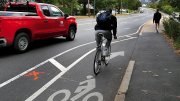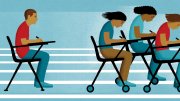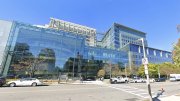Autumn evenings, light off the Charles River glistens through Memorial Drive’s rusting trees. In the crisp breeze, cyclists navigate around pedestrians on the Dr. Paul Dudley White Bike Path. But last September 24, an SUV upended that tranquil scene, careening onto the sidewalk and killing cyclist John Corcoran ’84.
In several ways, the crash that killed Corcoran represents the dangers plaguing American roadways. Insufficient separation between cars and people leads to fatal encounters. Large vehicles make crashes deadlier. And fractured governance slows improvements: although Memorial Drive traverses Cambridge, it is managed by the Commonwealth.
America’s roads claim about 40,000 lives annually. These deaths have become routine, often eliciting little to no mention even in the local press. But some Harvard affiliates are sounding the alarm about American roads—and are applying their expertise to help make them safer for all.
Speed Kills
On an unseasonably cool day this past August, a two-year-old boy toddled onto Boston’s Stanwood Street, a narrow neighborhood way lined on both sides with parked cars. A rideshare driver hit the child, whose blue-shirted body disappeared under the bumper, his hand flung upward. The driver slammed on the brakes; miraculously, the child survived.
But it was not a miracle that saved him. Mere feet before hitting the child, the driver had slowed for a speed hump. Though Boston chief of streets Jascha Franklin-Hodge cannot say with certainty the speed bump saved the child’s life, the former Harvard Kennedy School (HKS) fellow is glad the hump was there. “Had that car been going faster,” he says, “there’s a very good chance that kid would not have lived.”
Crashes, explains associate professor of surgery David Mooney, are “all kinetic energy.” Doubling a car’s speed quadruples its kinetic energy. “If you go just a little bit faster or a little bit slower, it’s a big difference,” he says. Only 10 percent of pedestrians die when struck by a vehicle traveling at 23 miles per hour—but a quarter die when the speed is 32 m.p.h., half at 42 m.p.h., and three-quarters at 50 m.p.h. Speed makes car-on-car and car-on-object collisions deadlier, too.
Accordingly, safety-minded road planners look for every opportunity to reduce vehicle speed. One might think speed could be reduced simply by lowering the speed limit, but reality is more complex. Stanwood Street’s posted speed limit of 20 m.p.h. (a “slow zone”) was reinforced by tightly parked cars, people unloading a car’s trunk, and speed humps—all physically encouraging the rideshare driver to go slowly. Jeff Speck, M.Arch. ’93, studies urban roads like this one, helping cities design safe, walkable streets through his firm, Speck Dempsey. In an urban environment, he says, drivers choose their speed based not on the posted limit but on “what feels safe and responsive in that context.”
But drivers and city officials often dislike the interventions that encourage slow speeds. Many local leaders desire “elbow room,” so a driver who is exceeding the speed limit by 5 to 10 m.p.h. can still proceed easily. Designing a road for a speed faster than its posted limit invites everyone to speed.
“Giving drivers a feeling of safety... makes them more dangerous.”
When working in cities, Speck aims for his roads to broadcast physically that drivers should travel slowly. He removes the yellow center line, which can reduce driven speeds by 7 m.p.h.; narrows lanes to 10 feet (shrunk from the highway-standard 12 feet or extra-wide 14 feet); and adds bike lanes, street trees, and curbside parking to make the street look narrow, causing drivers to exercise more caution. “Giving drivers a feeling of safety,” he says, “makes them more dangerous.”
One method of combating collisions is a “road diet”—removing lanes. Reducing a four-lane road to three lanes (one in each direction and one for turning) can decrease both speeds and collisions, often without affecting carrying capacity, says Speck. That extra space can be used to add separated bike lanes, expand sidewalks, and improve crosswalk visibility, enhancing biker and pedestrian safety. These road diets can spark local opposition, especially when businesses abut the street (they worry about ease of parking). But once implemented, these designs tend to be popular (or at minimum unnoticeable). “Every city has some streets that have more lanes than they need,” he says.
Such lane changes can be made simply and cheaply. Former secretary and CEO of the Massachusetts Department of Transportation (MassDOT) Jamey Tesler recalled the 2021 reduction of the Harvard Bridge from four lanes to two, which added separated bike lanes. “We started with cones and built that as a temporary installation,” says Tesler, a former HKS fellow. Once MassDOT saw that the new arrangement made bikers and drivers safer without increasing congestion, the department added flex posts and made the change permanent.
Attacking the Arteries
Counterintuitively, the safest American roads are the fastest ones. Per vehicle mile traveled, interstate highways claim fewer lives than any other type of road. Separating cars from other road users, making lanes wide and turns smooth, and minimizing intersections lead to a safe driving environment. But according to Speck’s business partner, former Massachusetts assistant secretary of transportation Chris Dempsey, M.B.A. ’12, “A century of highway engineering has made us less safe, not safer, when it comes to local roads.”
The most dangerous roads are arterials: the category between local roads and interstates. Though arterials move traffic at high speeds, most lack key features responsible for interstate safety. Frequent turnoffs into storefront parking lots make the left and right lanes hazardous. Abutting retail developments invite pedestrians. Bikers ride in the right lane or a painted bike lane, exposed to high-speed cars. Accordingly, arterials account for a majority of road deaths and about two-thirds of pedestrian deaths.
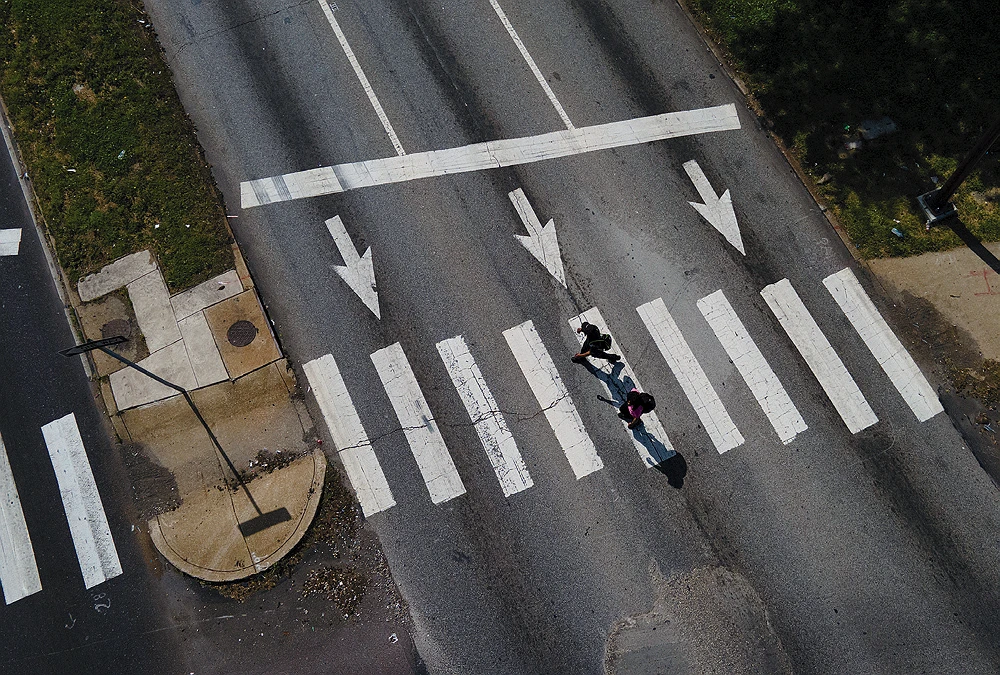
These roads can be especially hard to fix because they are frequently controlled by states rather than cities or counties. State-owned roads are often more dangerous than city-owned ones, says MIT Mobility Initiative senior fellow David Zipper, M.B.A ’07. In Vox, he wrote that two-thirds of crash deaths in the 101 largest metropolitan areas occur on state roads, even though states control only 14 percent of urban road miles nationwide. (State roads, points out Massachusetts state senator William Brownsberger ’78, J.D. ’83, tend to feature highway-like speeds and thus deadlier crashes.) States, Zipper argues, are generally slower to adopt safety interventions than cities and towns.
Layout Matters
Asphalt is the great connector, linking homes and schools, stores and theaters. In some locales, such as city centers, people have many ways to get around safely: bus, train, car, or foot. But arterial roads can usually be safely navigated only by car. Sprawling auto-oriented suburbs, which funnel people onto arterials, require more driving than denser layouts.
The safest environment is one where “you can get to where you need to go without driving.”
These additional daily miles add up quickly—and with them, the transit death toll. The safest environment is one where “you can get to where you need to go without driving,” says Graduate School of Design associate professor of urban planning Carole Voulgaris. “It’s not just the design of the street, but it’s the overall form of the cities.”
As housing becomes more expensive, Americans have increasingly been pushed out of walkable cities and into suburbs designed around the automobile. For lower-income residents, navigating car-centric neighborhoods without the expensive protection of a private automobile can be fatal. In April 2010, for example, Raquel Nelson got off a Cobb Community Transit bus with her three children. Her Marietta, Georgia, apartment was on the opposite side of a four-lane 45 m.p.h. arterial, and the nearest crosswalk was a third of a mile away. So, Nelson and her kids crossed the road without one, pausing in the concrete median island, as many of her neighbors did. But her four-year-old son ran ahead, where he was struck and killed by an impaired driver. Nelson was convicted of vehicular homicide—despite the fact that she did not own a car. Zipper says that incident is “so emblematic of how messed up we are in this country when we think about road safety….You blame a bereaved, distraught mother, instead of recognizing this is an utter failure of roadway design.”
Dangerous Drivers
But sometimes targeting individuals can improve road safety. In the mid 1980s, Jay Winsten launched the Center for Health Communication at the Harvard School of Public Health. Soon after, WBZ-TV reporter Dennis Kauff was killed by a drunk driver. “The press corps had lost one of their own,” recalls Winsten. “They were enraged.” Channeling that anger, he convened 45 local journalists to discuss how the media could educate about drunk driving.
Though the campaign began with local news media, Winsten soon looked to Hollywood. In the late 1980s, he persuaded television screenwriters to incorporate drunk-driving prevention into 160 primetime episodes. Characters were driven by (and served as) designated drivers, and bartenders confiscated drunk characters’ keys. He wanted the messaging to be positive—the designated driver is (literally) the life of the party—rather than the negative (“don’t drink and drive”). Such messaging seems to have resonated. After remaining constant throughout the mid ’80s, alcohol-related traffic fatalities fell by a quarter during the first four years of the campaign, a period when non-alcohol-related road deaths declined by only 5 percent. (And the progress has continued: whereas in 1993, 59 percent of young adults reported serving as a designated driver, by 2008, that figure rose to 72 percent. )
Winsten’s latest target is distracted driving. Pedestrian deaths began to rise in 2009—two years after the iPhone’s debut. Now director of the Chan School’s Road Safety Initiative, he says drivers distracted by their devices stop looking left and right and just focus straight ahead. But in this fractured media market, he has struggled to share his message: encouraging empathy for all road users. “We haven’t moved the needle,” he says. “No one’s been able to break through.”
Both pedestrians and drivers navigate the streets while distracted, but planner Chris Dempsey emphasizes that distracted driving is far worse than distracted walking. “When you make a mistake as a pedestrian, you are putting yourself in harm’s way,” he says. “When you make a mistake as a driver, you are putting other people in harm’s way. They are not the same.”
Designing “Complete Streets”
Roads have not always been the domain of the car. In the early days of driving, cars had to share space with other road users like horses, trams, and people. But as the automobile grew more popular, American cities cleared the chaos, essentially granting cars exclusive use of streets. That did not make roads safer. By 1934, more than 30,000 Americans were dying on roads annually.
During his tenure as U.S. Secretary of Transportation in the Obama administration, HKS Bloomberg professor of the practice of public leadership Anthony Foxx wanted to “hearken us back” to that era when “a street would be designed for any user who chose to access that street.” In 2014, he debuted the “Safer People Safer Streets” initiative, hoping to get localities to implement “complete streets” designed for drivers, bikers, and walkers. That program, with its focus on data collection, local-federal collaboration, and multimodality, laid the groundwork for the Department of Transportation’s present “Safe Systems” approach. That tactic, which then-U.S. Secretary of Transportation Pete Buttigieg ’04 debuted in 2022, encourages safer driver behavior, roads, vehicles, and speeds, alongside better post-crash care.
Building safe, complete streets that tell drivers to proceed slowly and safely is hard work. Foxx noted that North Carolina, where he served as mayor of Charlotte, has about 80,000 lane miles of highway (a designation that does not just include interstate-style roads). “There isn’t enough cash coming through the door to fix all of these roads to a ‘complete street’ standard at one single time,” he says.
Even with this balanced approach, MIT’s Zipper cautions against placing too much agency in drivers’ hands. Americans, he says, love to “blame individuals for what really are systemic and societal problems.” He recommends that safety advocates focus on highway engineers, construction companies, and policymakers, “separately from the road users, who are just going about their daily business. It’s not their job to build a safe system.”
Emphasizing Enforcement
Around Halloween, American drivers might encounter electronic highway signs reading, “HOCUS POCUS DRIVE WITH FOCUS.” While that punny message might not compel them to keep their hands off their phones, another type of sign might. This past April, Washington State’s King County debuted four “SmartSigns” that use infrared technology to check whether drivers are handling their phones. During the four-month pilot, activation of the signs did not result in citations. Instead, the signs simply flashed “Phone down” for texting drivers and “Slow down” for speeders.

Automated cameras can detect a wide range of driving infractions: speeding, running red lights, and blocking bus or bike lanes. But many states ban or restrict automated enforcement. Such was the case in Massachusetts until January 2025, when the legislature legalized cameras mounted on city and school buses. These cameras can ticket drivers for parking at a bus stop or passing a stopped school bus that has deployed its stop sign. Governor Maura Healey’s ’92 pending budget contains a provision that would legalize speed cameras, too. (This paragraph has been updated from the print issue to reflect the new legislation.)
Cameras allow police to penalize offenses that were already illegal. Senator Brownsberger has helped legalize road safety measures such as a hands-free cell phone requirement and a passing distance of four feet between cars and bicycles or pedestrians. Although he recognizes that these laws are often poorly enforced, he still believes they are worth pursuing. “There are basic traffic rules that we leave in place even though people do not comply with them entirely because we hope that most people of goodwill…are going to comply with them,” he says. “The purpose of law is to make clear what the expected and hoped-for behavior is.”
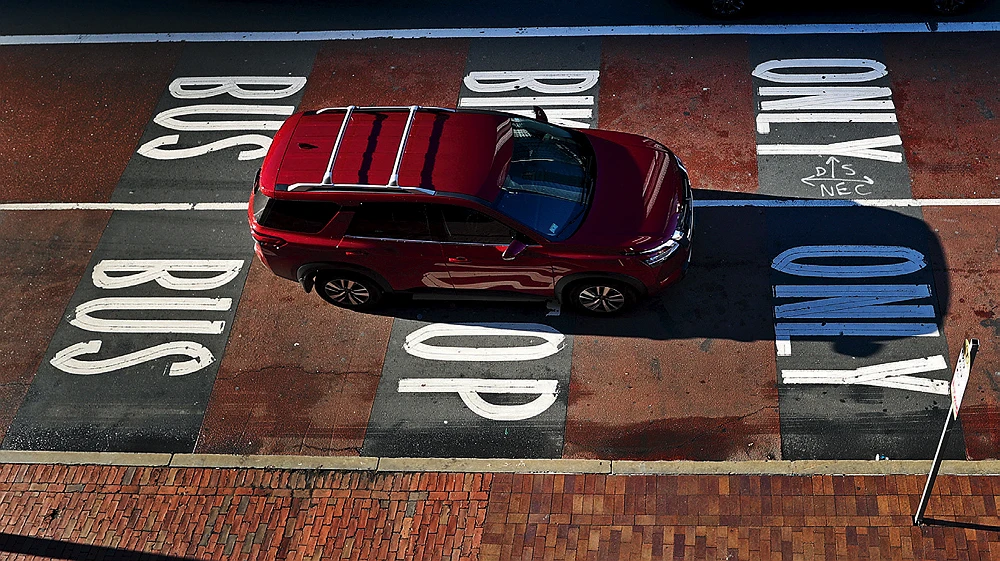
Some regulations are well-enforced. Many cities and states mandate a speed limit of 15 or 20 m.p.h. for e-scooters. Shared e-scooters, commonly found strewn across city sidewalks, do not allow their riders to exceed the local limit. “It was just so striking that we do this with these scooters that weigh 45 pounds,” says Zipper, “and yet, someone who’s driving an SUV that weighs 4,500 pounds or more can drive as fast as they want, and there is no throttling at all in an urban area.”
Car Bloat
An important element of Zipper’s concern is vehicle weight. As surgeon David Mooney noted, crash severity is determined by kinetic energy. Doubling the weight of a car doubles its kinetic energy. The increasing heft of American automobiles threatens to undo decades of technological progress in vehicle safety.
In the early 1970s, road deaths averaged close to 50,000 a year. Rapid suburbanization increased the number of miles driven and, with it, the number of deaths. In the following decades, seatbelts, airbags, and crumple zones helped people survive previously fatal crashes, making driving far safer per mile than in prior decades.
But one change in car design, nominally invoked in pursuit of safety, has the potential to reverse all of those safety improvements. For people inside a car, a larger vehicle is safer because it is better able to shelter its occupants during a collision. For people outside the car, though, large cars are quite dangerous. For every life that the heaviest 1 percent of SUVs and trucks save, according to an analysis by The Economist, more than a dozen lives are lost in the other, smaller vehicles with which the behemoths collide.
Now, drivers are stuck in an arms race. To protect themselves from large cars (among other factors shaping their preferences), drivers are buying bigger cars. In 1990, one-quarter of new cars purchased by Americans weighed more than 4,000 pounds. In 2023, more than three-quarters did. Those unable to upsize, like bikers and pedestrians, suffer the most: pedestrian deaths have doubled since 2009.
These larger vehicles can also be shaped more dangerously. The higher driver’s seat and longer hood severely restrict visibility. Last summer, NBC News sat children down in lines stretching backward from the front bumpers of large SUVs and found that in some models a 5-foot-2 driver could not see the first 10 children in the row. A higher hood also makes pedestrian crashes more severe. When a sedan collides with a walker’s legs, the pedestrian flies up onto the hood, but SUVs and pickup trucks collide with an adult’s torso or child’s head and send the victims under the vehicle.
Zipper calls the size increase “car bloat” and says that it unleashes “a cornucopia of societal issues.” Not only are larger cars bad for others’ safety, they take up more curbside space, shed more particulate pollution from their tires, and wear down roads more quickly. (They also use more fuel and emit more carbon dioxide.) “Our policies, which should be regulating it…at the federal level actually encourage it,” he says. Through the tax code and fuel economy rules, “We’re doing exactly the opposite of what we should be doing.”
Automating Vehicles
While some people are focusing on achieving safety by decreasing vehicle size, others are looking towards vehicle operators. In July 2023, Cruise, an autonomous vehicle (AV) manufacturer owned by General Motors, took out a full-page advertisement in The New York Times declaring “Humans are terrible drivers.” The ad continued, “Cruise driverless cars are designed to save lives….They also never drive distracted, drowsy, or drunk.”
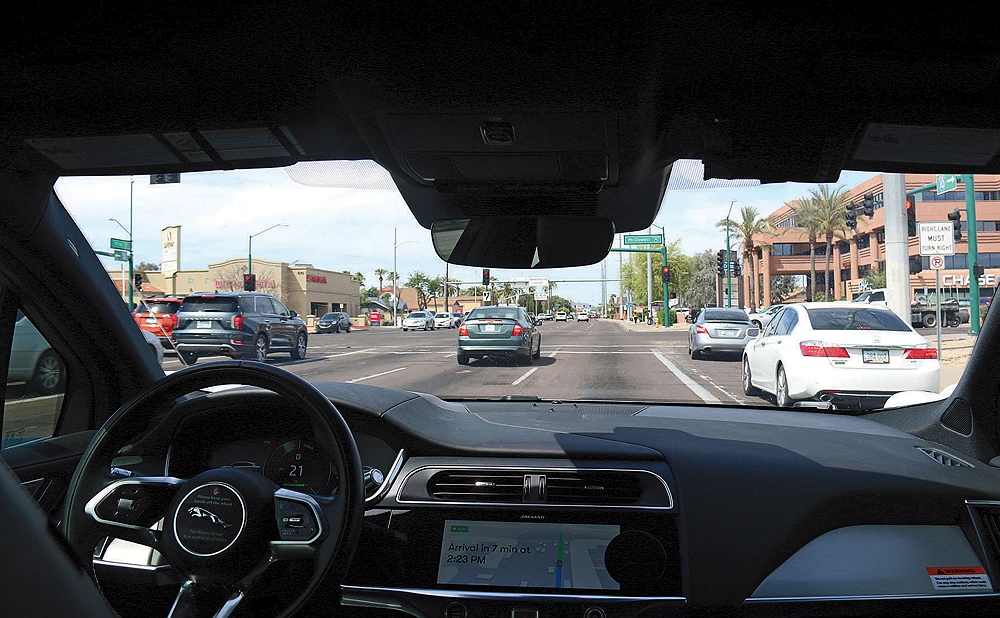
Though autonomous vehicle companies claim their vehicles are safer than human drivers—Cruise said its vehicles were “involved in 92 percent fewer collisions as the primary contributor”—that sentiment is not yet widely accepted, nor is the technology, still experimental, yet in wide use. “So far, the data on self-driving cars is mixed,” says Damien Bérubé, a chemical physics doctoral student and an affiliate of the HKS Autonomous Vehicles Policy Initiative. Google’s Waymo, for example, had logged roughly 33 million driverless miles as of September 2024. That year, one American died for every 85 million vehicle miles traveled, a distance Waymo has not yet driven (though Bérubé notes the company has simulated tens of billions of miles on many types of roads). And Waymo’s real-world data come primarily from its urban ride-hailing service, where its cars likely spend more time driving slowly in cities than the average American driver does.
Though autonomous vehicles may not drive distracted, they do make errors that no reasonable human driver would. In October 2023, a human-driven car in San Francisco hit a pedestrian, who was then flung underneath a Cruise robotaxi nicknamed “Panini,” which kept driving. A human, says HKS public policy lecturer Mark Fagan, would have seen the pedestrian fly under the car, so would have stopped. “There are an infinite number of edge cases,” he says, “Things that you just couldn’t imagine,” and thus are difficult to code or simulate.
AV detractors have other concerns, too. Chris Dempsey fears that making driving easier will flood streets with cars, negating any efficiency benefits from autonomous driving. A few years ago, he spoke to a woman at a public forum who realized that, with autonomous vehicles, she would be able to “put my dog in the car and send it to the chiropractor,” he recalls. “The limiting function of driving is congestion for most people….If all of a sudden, she can stay home and just put the dog in the robotaxi, that dog is going to get chiropractic every week.”
But the allure of autonomy remains, not least because AV development is privately funded—an attractive proposition compared to publicly funded safety interventions on roads. “Don’t let one or two bad events end the experiment to see if [autonomous vehicles] can really be safer,” Fagan says. “We didn’t do it with aircraft, and we didn’t do it with cars way back when. We just kept going.”
Challenging Complacency
Too often, tragedy must precede change. Drivers, bikers, and transit advocates had long complained about the stretch of Memorial Drive where John Corcoran was killed, known as the BU Bridge Corridor. There the bike path combines with the sidewalk (where Corcoran was struck) and then continues onto the road without separation.
Two months after Corcoran’s death, the Massachusetts Department of Conservation and Recreation (DCR), which maintains Memorial Drive, widened the BU Bridge Corridor’s sidewalks, restriped pedestrian crossings, and reduced the speed limit from 35 to 25 m.p.h. Now, DCR is working with MassDOT to further assess Memorial Drive’s connection with the BU Bridge and is analyzing local traffic patterns, including a potential road diet that may trade two car lanes in some sections for expanded parkland and pathways.
Despite grand visions of road safety, the path to safer streets might look like DCR’s emergency changes: small, incremental steps to improve known problem spots. But there need not be a tragedy to bring change. Road designers can induce slower speeds. Urban planners can narrow arterials and simplify driving patterns. Local governments can improve walkability and pedestrian safety. Legislatures can strengthen enforcement. Manufacturers can restrict car size. Drivers can put down their phones. After decades of continued carnage, people could begin to take road safety more seriously.
